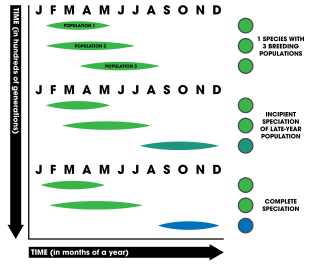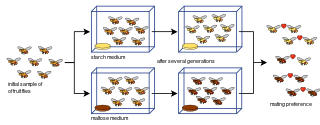| Species | Description |
|---|
| Acropora samoensis * and other Acropora spp.* | Japanese corals found to be reproductively isolated by the timing of their spawning. [5] Sympatric species populations of A. samoensis coral spawn separately in the fall and spring with spawning being a heritable, likely involving the PaxC gene. [15] |
| Montastraea annularis*, M. faveolata*, and M. franksi * | Three related species of coral that have speciated due to the timing of their spawning. [6] |
| Oncorhynchus nerka *, O. gorbuscha *, and O. tshawytscha | Yearly breeding runs of Sockeye salmon occur during two periods in the year (late and early) have caused genetic isolation of incipient populations. Salmon breeding is known to be genetic but no specific genes are known for this species. [7] [16] [17] Even and odd two-year life cycles in conjunction with seasonal breeding runs of pink salmon (O. gorbuscha) has driven genetic differentiation between the two populations. [18] [19] [20] [21] [22] Breeding run times also vary across the population range of the Chinook salmon (O. tshawytscha). [23] [24] |
| Thaumetopoea pityocampa * | Codominance in genes is associated with the emergence time for larval stages of this moth species. Winter and summer larval populations are in the process of speciating. [25] [26] [27] |
| Inurois punctigera* | Breeding is prevented in areas where mid-winter temperatures are unsuitable for the moth species. This has given rise to late and early populations. [28] |
| Pemphigus populi-transversus* and P. obesinymphae* | The gall-forming aphids produce galls on different leaves of the same host tree species. P. populi-transversus forms galls on early spring leaves while P. obesinymphae forms them on leaves in the summer. This has led to full reproductive isolation. [29] |
| Asphondylia spp.* | Three midge species infect the stems of Larrea tridentata , A. auripila in summer, A. resinosa in winter, and A. foliosa in spring. [30] |
| Cellana spp.* | Inhabiting different depths within centimeters, the limpets have become reproductively isolated likely due to a combination of parapatric speciation and spawn cues (e.g. spawning according to water level. [31] |
| Hydrobates spp.* | The petrels group has reproductively isolated (in the Azores) and incipient species (other archipelagos) caused by cool and warm breeding seasons. [32] [33] [34] |
| Howea belmoreana * and H. forsteriana * | Genetically controlled flowering times have caused (in conjunction with differing soil pH levels) the reproductive isolation of two palm species on Lord Howe Island. [35] |
| Erysiphe necator * | Exhibits evidence of isolation due to temporal differences of its host species Vitis vinifera . [36] |
| Magicicada spp.* | Groups of 13- and 17-year life cycle species pairs (seven species total) of cicada emerge to reproduce separated by large time frames between breeding seasons. [37] [38] [8] Only every 221 years do the 13 and 17 year cycles align where both pairs emerge simultaneously. [2] |
| Antitrogus parvulus * | Two beetle cohorts express genetic differentiation from life cycles separated by two-year intervals. [39] |
| Oeneis melissa semidea* | Two-year life cycles of the butterfly species breeding groups have caused genetic differentiation. [40] |
| Bambusoideae* | Bamboo undergo semelparous reproduction where they live for years before mass-flowering at once. This can happen in different years and different locations. Allochronic patches are thought to have driven the diversification of global bamboo species. [41] [9] [42] |
| Spodoptera frugiperda | A phytophagous example of two moth larvae strains breeding on either corn or rice at different times of the night. Other causes of isolation may be acting on the species. The population in the United States appears to be speciating via allochrony; [43] [44] however the population in Columbia does not. [45] |
| Anopheles gambiae and A. coluzzii | Controlled by circadian rhythms that stimulate mating, the mosquitos swarm at slightly different times during twilight exhibit some evifence of allochrony, though it is possible that reinforcement or microallopatric speciation is at play. [46] [47] |
| Bactrocera tryoni and B. neohumeralis | Only laboratory hybridization has been observed between the two Queensland fruit flies, the latter of which mates only during the day time, while the former mates only at night. [48] |
| Anastrepha bistrigata and A. striata | The fruit flies mate during morning and afternoon respectively. Courtship behavior could also be isolating the two species. [49] |
| Salmo salar | The age at full maturation as well as genetic differentiation varies between one- and three-year Atlantic salmon (these are the years in which the young fish leave to the ocean and return to their breeding grounds). [50] |
| Anguilla anguilla | European eels have varying rates that they mature based on environmental factors. This creates separated breeding populations that show some genetic differentiation—notably between 2–3 year breeding intervals. [51] |
| Cuculus canorus | Allochrony likely plays a role in the Cuckoo bird as they depend on host species for rearing their young. Hosts lay eggs at different times, and cuckoos depend on these timeframes to replace a host bird's eggs. [52] |
| Antechinus spp. | The marsupial mice respond strongly to photoperiodic cues and in sympatric populations, reproductively isolated species are found to breed at different times. [53] |
| Coregonus clupeaformis | The lake whitefish has two known forms, normal and dwarf. They have different spawning times but may have diverged in allopatry. [54] [55] |
| Exapion ulicis and E. lemovicinum | E. lemovicinum infects Ulex minor and U. gallii plants while E. ulicis infects U. europaeus . The timing in which they lay eggs on the plant occurs in fall and spring respectively. [56] |
| Meconopsis autumnalis and M. paniculata | Himalayan poppy are a fully reproductively isolated species thought to have speciated through allochrony as they exist in sympatry and flower at different times in the season. [57] |
| Cordia spp. | Some of the species in the genus exhibit significant variation in flowering times. [58] |
| Hesperiidae | It is thought that temporal isolation is responsible for speciation in many of the 400 skipper butterfly species studied. [59] |
| Bryopsidales spp. | The green algae reproduces by releasing gametes at different times. This is thought to have driven reproductive isolation, but it is unclear if it is genetically controlled or based purely on environmental cues. [60] |
| Chilo suppressalis | Mate timing occurs at different intervals at night as well as dependence on different host plants. [61] |
| Prodoxus quinquepunctellus | Host races of the moths inhabit Adam's needle and thread yucca with larval emergence occurring in conjunction with flowering time. It is thought that morphology and host-shifting contribute alongside allochrony. [62] |
| Gryllus pennsylvanicus and G. veletis | The spring field crickets have been described as speciating in allochrony due to their maturation timing. [63] However more recent studies indicate that they are not sister species. [64] |
| Haemaphysalis spp. and Dermacentor spp. | Three Hungarian tick species in the Haemaphysalis genus exhibit mating activity in sympatry during three seasonal periods, late fall, late spring, and early spring. Two tick species in the Dermacentor genus show peak activity in fall and spring. [65] |
| Strauzia longipennis | Genetic variation is detected in three sunflower maggot fly variants that inhabit the same host plant. Their larval emergence occurs in three distinct periods of the summer keeping them partially isolated. Experimental manipulation suggests allochrony will increase as they continue to diverge. [66] [67] |
| Enchenopa binotata complex | The phenology of members in the treehopper species complex is correlated with their host plants—when changing host species in experiment, the treehopper egg hatching time changes promoting assortive mating. [68] |
| Milicia excelsa | With flowering time of the African teak thought to be genetically controlled, the population exhibits isolation. [69] |
| Asteralobia sasakii | Two populations of Cecidomyiidae gall midges differ substantially in emergence time (with no overlap) on two different Ilex hosts. [70] |
| Salix spp. | The Canadian willow species are found to isolated by flowering time; three of which flower early ( S. bebbiana , S. discolor , S. eriocephala , and S. petiolaris ) and late ( S. amygdaloides , S. exigua , and S. lucida ). Hybrids are not known outside of laboratory settings and exhibit intermediate flowering times. All seven species exist in sympatric distributions. [71] |
| Juncus effusus | Sympatric populations of genetically differentiated plants flower at different times preventing hybridization. It is unclear if speciation is occurring by allochrony as reinforcement may be a stronger explanation. [72] |
| Agrostis tenuis | The grass species A. tenuis grows on soil contaminated with high levels of copper leached from an unused mine. Adjacent is the non-contaminated soil. The populations are evolving reproductive isolation due to differences in flowering time. [73] |
| Anthoxanthum odoratum | The grass species A. odoratum grows on soil contaminated with high levels of lead and zinc leached from an unused mine. Adjacent is the non-contaminated soil. The populations are evolving reproductive isolation due to differences in flowering time. [73] |
| Chironomus nuditarsis | The non-biting midge (genus Chironomus ) exhibits differences in life cycle in accordance with elevation. [74] |
| Terellia fuscicornis | Differences in courtship behavior as well as morphology are found in populations that infect different hosts ( Silybum marianum and Cynara ) that bloom at different times. [75] |
| Ampelomyces spp. | Genetically different strains of the mycoparasitic fungus that infects apple powdery mildew completes their lifecycle before other strains that infect other mildew hosts. [76] |
| Glycine max and G. soja | Wild soybean (G. soja) and cultivated soybean (G. max) can be prevented from hybridizing by inducing asynchrony in flowering time. [77] This study is unique in that it is not an example of allochronic speciation, but instead an experiment demonstrating that allochrony can be experimentally applied to induce isolation. |
| Parasitoid wasps: Rhagoletis pomonella , Rhagoletis mendax , Diachasma alloeum , Diachasmimorpha mellea , and Utetes canaliculatus | In R. pomonella (one of the most researched, model organisms), genetic data indicates heritability of emergence and its associated flight time. [78] In commercial blueberry fields versus wild ones, the populations of R. mendax differ in their flight periods causing a reduction in gene flow. [79] Other Rhagoletis species that host on Crataegus show similar patterns. [80] Cospeciation of the parasitoid wasps (D. alloeum, D. mellea, and U. canaliculatus) and their host plant apple maggot has been induced by host-shifts caused by various factors such as timing of its egg hatching, fruit smell preference, philopatry, and avoidance. The egg hatching timing factor implicates allochrony. [81] |
| Eurosta solidaginis | Two populations of goldenrod gall fly differ in their emergence periods on their host plants Solidago altissima and S. gigantea by 10 to 14 days preventing hybridization and causing isolation. [82] |
| Falco sparverius | Kestrels of Idaho have both migrating and year-round residents with the year-round population nesting earlier generating assortive mating. [83] |
| Sylvia atricapilla | Some genetic differentiation exists between blackcap populations that migrate to the United Kingdom and Ireland versus those that migrate to Iberia. The birds breed in sympatry in Germany; however, the UK and Ireland populations migrate back earlier causing assortive mating. Hybrids end up with intermediate migration routes. [84] |
| Junco hyemalis hyemalis and J. h. carolinensis | Photoperiodic cues drive earlier development of the gonads in J. h. carolinensis of whom migrate to a different region to breed while only residing sympatrically with J. h. hyemalis birds for half of the year. [85] |
| Daphnia pulex and D. pulicaria | Very limited isolation is detected between the two water flea species (D. pulicaria is within the D. pulex complex) possibly the result of reproductive timing based on photoperiodic cues. [86] |
| Tibicina | Habitat isolation, allochrony, and allopatry were identified in various pairs of seven species and subspecies of the genus (T. Corsica Corsica, T. Corsica fairmairei, T. garricola, T haematodes, T. nigronervosa, T. quadrisignata, and T. tomentosa). [87] |
| Kaltenbachiella japonica | The galling aphids depend on the budding of Japanese elm to hatch. Incipient populations have arisen due to changes in the budding times of the host plant. [88] |
| Scolioneura betuleti and S. vicina | The leaf-mining sawflies, despite being very similar, show some evidence of divergence due to seasonal flying (fall and spring respectively). [89] [90] |
| Papilio canadensis and P. glaucus | The two butterfly species have hybridized creating a hybrid population that breeds during a different time than the parent populations. Genetic evidence indicates that genes control the timing of reproduction. [91] [92] |
| Tyrannus savana | Fork-tailed flycatcher populations are diverging due to isolation by a change in breeding times and breeding grounds as a result of a loss of migratory behavior. [93] |
| Ostrinia nubilalis | Corn borer moth strains breed at differing times of the night are considered to be incipient, however it is unclear if allochrony is exclusively causing isolation. [94] Seasonal breeding may keep North American populations isolated as the number of yearly broods (voltinism) between the two strains. Sympatric to each other, Z strain is monovoltine (having a single brood in a year) and the E strain is divoltine (having two broods in a year). [14] In Europe, there is a correlation between larval emergence time and the host plant. [95] |
| New World bird species | In an experiment testing the Asynchrony of Seasons Hypothesis (see section below), 57 different bird species found across the New World (North and South America) were found to express increased genetic differentiation in correlation with living in areas that have asynchronous precipitation. [96] |

















